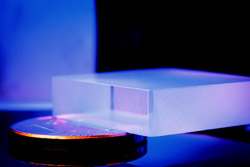Edge-rounding and removing burrs of glass parts with laser radiation

Part made of quartz glass, laser-polished and edge-rounded.<br><br>Picture Source: Fraunhofer ILT / Volker Lannert, Aachen<br>
It can be used not only for polishing surfaces, but also for rounding edges and for removing burrs e.g. split lines on parts formed by injection or compression molding. At the 2012 glasstec international trade fair, which will take place in Düsseldorf from October 23 to 26, experts from Fraunhofer ILT will be explaining the process and displaying samples of glass parts whose edges were rounded with CO2 laser radiation.
The stability of glass parts can be significantly increased by rounding their edges. Laser polishing is an economical and fast technique for edge-rounding of glass parts. When, as in laser polishing, a glass edge is processed with a CO2 laser, the material at the outermost surface layer heats up due to the surface near absorption of 80 percent of the laser radiation. A temperature just below its evaporation temperature is reached in the outher surface. This greatly decreases the viscosity of the material, while surface tension reduces the surface roughness. In contrast to conventional polishing techniques, no material is removed from the surface with laser polishing.
In addition, the surface of the edge is polished. Subsequently, the edge surface and adjacent areas exhibit a very low level of micro-roughness. The result is not only greater stability in the edge region, but also a noticeable increase in the gloss level of the processed area.
“You can set the degree to which the edge is to be rounded and polished by means of the process temperature in the surface near layer,” explains Annika Richmann, project manager at Fraunhofer ILT. “Although parts are usually processed using a beam diameter of several millimeters, very local processing is also possible. Laser polishing can be used on virtually all types of glass, with greater process speeds obtainable for low-melting glasses.”
Bid farewell to tangible and visible burrs
The technique is also suited to removing burrs on glass and plastic injection and compression-molded parts. As in laser polishing, material is redistributed rather than removed; burrs are diminished to the point where they can no longer be seen or felt. This technique also greatly reduces the micro-roughness of the processed areas and heightens gloss.
Polishing freeform optics
Research at Fraunhofer ILT is presently focused on applying laser polishing techniques to freeform optics, where conventional polishing techniques are very slow. Lasers shorten processing times by a factor of up to 100, depending on the surface geometry to be polished. For many applications – including optical systems for illumination optics – the roughness values now obtainable are more than adequate. The challenge for the experts charged with further developing the laser polishing technique now consists in also attaining adequate roughness for imaging optics by means of further increasing shape accuracy and reducing waviness.
For further information
Dipl.-Phys. Annika Richmann
Group Polishing
Phone +49 241 8906-282
annika.richmann@ilt.fraunhofer.de
Dr. Edgar Willenborg
Head of the Group Polishing
Phone +49 241 8906-213
edgar.willenborg@ilt.fraunhofer.de
Fraunhofer Institute for Laser Technology ILT
Steinbachstr. 15, 52074 Aachen, Germany
Media Contact
More Information:
http://www.ilt.fraunhofer.deAll latest news from the category: Process Engineering
This special field revolves around processes for modifying material properties (milling, cooling), composition (filtration, distillation) and type (oxidation, hydration).
Valuable information is available on a broad range of technologies including material separation, laser processes, measuring techniques and robot engineering in addition to testing methods and coating and materials analysis processes.
Newest articles

High-energy-density aqueous battery based on halogen multi-electron transfer
Traditional non-aqueous lithium-ion batteries have a high energy density, but their safety is compromised due to the flammable organic electrolytes they utilize. Aqueous batteries use water as the solvent for…

First-ever combined heart pump and pig kidney transplant
…gives new hope to patient with terminal illness. Surgeons at NYU Langone Health performed the first-ever combined mechanical heart pump and gene-edited pig kidney transplant surgery in a 54-year-old woman…

Biophysics: Testing how well biomarkers work
LMU researchers have developed a method to determine how reliably target proteins can be labeled using super-resolution fluorescence microscopy. Modern microscopy techniques make it possible to examine the inner workings…





















